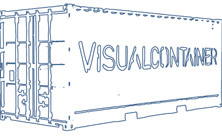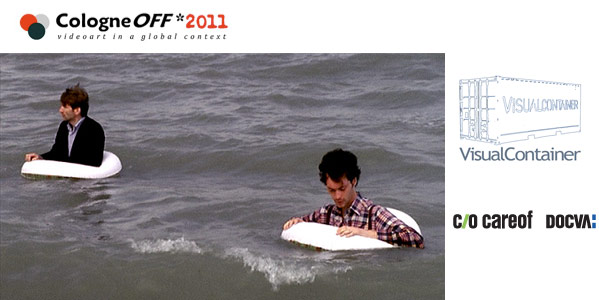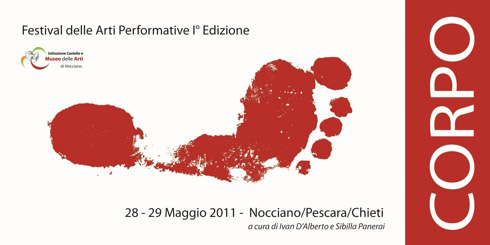Latest news
Iscriviti alla Newsletter
Set
23
26/28 May 2011
COLOGNEOFF 2011 e ARTELES
presents:
ITALIANIAN CHARACTER, A NATIONAL ART MOLESKINE
curated by: VisualContainer + Care/of
Screening: 26 May 2011
ARTELES,
Hahmajarventie 26
38490 Haukijarvi
Finlandia
CologneOFF 2011 Tampere is collaboration between Cologne International Videoart Festival, artvideoKOELN; Le Musee di-visioniste – the new museum of networked art – and Arteles & Galleria Rajatila – Tampere
ITALIANIAN CHARACTER, A NATIONAL ART MOLESKINE
What result can offer art about contemporary Italy then? What identity would offer the most recent works by our artists facing their time?
In such a context, videoart seems to be one of the most favourite and useful media to take the pulse of the real and provide the most adherent image to what we may call contemporary Italy of early third Millenium.
In the third-millenium artworks by Italian videoartists, the investigation of single and collective identity within the “Italian system” has become a crux: in the first decade of Y2K, they express a tormeting will to be in direct contact with the daily living, and the need for a umbilical cord to the most ordinary back-grounds and relevant rules and rhythms, urban and anthropological environments and peculiar problems.
On such basis, VisualContainer and Careof, two Milan-based not-for-profit organisations devoted to the promotion of Italian videoart within the international art environment, join their forces into a videoart exhibition to be shown at the Italian Cultural Institute, and presenting a most original and contemporary insight into the Italian character as it is being perceived by young artists.
Within the proposed selection, some videoartists investigate and show contemporary society in real time, thus offering a new format of socially committed documentary. Others would rather go for the most sophisticated chances of post-editing or directly creating images by resorting to other languages such as animation or television and movie found footage, eventually accessing to a presentation that rejoices any mimesis and doesn’t show the real as its is, but rather expresses its logic and properties.
Contemporary is clearly apparent in the great social issues, particularly the ones played by anyone being different or emigrant, which are sometimes filled in with empathy by the artist and sometimes ironically addressing political institutions that seems to be providing nothing but an apparent and simplistic solution.
by: Giorgio Fedeli (Visualcontainer)
Care/of video selection:
Michela Formenti – Senza respiro e voce [breathless and voiceless], 7’13”, 2005
Alberto Guidato – Fratelli d’Italia – 1’30”, 2002
Francesco Lauretta – Condizioni marginali [marginal conditions], 9’03”, 2002
Adriano La Licata – il tradimento del ponte [the bridge’s betrayal], 4’00”, 2008
Christian Niccoli – Planschen, 5’05”, 2008
VisualContainer video selection:
Alessandra Arnò – One shot, 0’42”, 2003
Elena Arzuffi, Domestic parkour, 04′ 32″, 2007
Barbara Brugola – Fingers 2.0, 2′ 25″, 2009
Iginio De Luca – L’urdemo emigrante, 2’45”, 2008
Maria Korporal – Passing by 07′ 39″, 2008
Sabrina Sabato – Tr-E2.flv, 18′ 00″, 2003
Natalia Saurin – Dance dance dance, 4’20”, 2009
CologneOFF – Tampere Programme
CologneOFF 2011 – videoart in a global context designed, coordinated, curated and directed by:
Wilfried Agricola de Cologne
Set
23
26/28 Maggio 2011
COLOGNEOFF 2011 e Arteles presentano:
Italianità: un moleschino italiano
progetto a cura di VISUALCONTAINER + CARE/OF – DOCVA
Screening: 26 maggio 2011
ARTELES,
Hahmajarventie 26
38490 Haukijarvi
Finlandia
CologneOFF 2011 Tampere è in collaborazione con Cologne International Videoart Festival, artvideoKOELN, Le Musee di-visioniste – il nuovo museo di arte in rete – e Arteles & Galleria Rajatila – Tampere
La programmazione internazionale di CologneOFF presso Arteles ospiterà tra i vari festival e progetti curatoriali da tutto il mondo:
Italianità: un moleschino italiano
Cosa può dunque risultare e risaltare oggi dell’Italia volgendo lo sguardo all’arte? Quale l’identità che ci trasmettono i lavori più recenti dei nostri artisti, nel confronto col proprio tempo?
In questo contesto, la videoarte sembra essere oggi il mezzo favorito e più consono per tastare il polso del reale e fornire l’immagine più aderente ad una possibile “contemporaneità” dell’Italia d’inizio terzo millennio.
Nelle opere dei videoartisti italiani del terzo millennio, l’indagine dell’identità individuale e collettiva nel “sistema Italia” costituisce un nodo cruciale: nel primo decennio del Duemila, il loro lavoro esprime in maniera assillante la volontà di un confronto diretto con le forme del vivere quotidiano, la necessità, sino all’urgenza, di un collegamento ombelicale con la vita più comune, le sue logiche, i suoi ritmi, i suoi spazi urbani ed antropologici, i suoi problemi specifici.
VisualContainer e Careof di Milano, realtà no-profit da anni impegnate nello studio e valorizzazione della videoarte italiana con partecipazioni a livello internazionale, propongono pertanto una selezione di opere video dell’ultimo decennio, per una mostra presso l’Istituto Italiano di Cultura in grado di fornire uno sguardo originale ed attuale su un’Italia vista da giovani artisti.
Nell’ambito della selezione proposta, alcuni videoartisti analizzano e riportano in presa diretta la realtà sociale contemporanea, proponendo una nuova forma di documentario socialmente impegnato. Altri scelgono invece le più sofisticate possibilità di alterazione o creazione delle immagini, rese possibili anche dall’utilizzo di altri linguaggi come l’animazione o il repertorio televisivo e cinematografico, originando una presentazione non mimetica, non affidata alla riproposta del reale tout-court, in grado comunque di fornirne le logiche e le proprietà.
La contemporaneità risalta subito nei grandi temi del sociale, in particolare nelle problematiche del “diverso” e dell’ “emigrato” , restituite ora con attenzione simpatetica da parte dell’artista, ora con ironica focalizzazione sulle istituzioni politiche incapaci di dare una soluzione che non sia di facciata e semplicistica.
by Giorgio Fedeli (Visualcontainer)
Care/of video selection:
Michela Formenti – Senza respiro e voce [breathless and voiceless], 7’13”, 2005
Alberto Guidato – Fratelli d’Italia – 1’30”, 2002
Francesco Lauretta – Condizioni marginali [marginal conditions], 9’03”, 2002
Adriano La Licata – il tradimento del ponte [the bridge’s betrayal], 4’00”, 2008
Christian Niccoli – Planschen, 5’05”, 2008
VisualContainer video selection:
Alessandra Arnò – One shot, 0’42”, 2003
Elena Arzuffi, Domestic parkour, 04′ 32″, 2007
Barbara Brugola – Fingers 2.0, 2′ 25″, 2009
Iginio De Luca – L’urdemo emigrante, 2’45”, 2008
Maria Korporal – Passing by 07′ 39″, 2008
Sabrina Sabato – Tr-E2.flv, 18′ 00″, 2003
Natalia Saurin – Dance dance dance, 4’20”, 2009
Programmazione di CologneOFF – Tampere
Un progetto di CologneOFF 2011 – videoart in a global context –
Diretto, coordinato e ideato da:
Wilfried Agricola de Cologne
Set
23
CORPO (BODY): Performative Arts Festival (1st edition)
At: MAAAC – MUSEO E ARCHIVIO DEGLI ARTISTI ABRUZZESI CONTEMPORANEI –Nocciano (PE) Italy
and
Florian Teatro Stabile d’Innovazione in Pescara
Teatro Marrucino in Chieti.
28 & 29 May 2011
BODIES AND CONTEMPORARY SPACES: videoart visions
The urgency for a vision over ourselves and the others has paved the way for one of the earliest investigations in videoart history: the body, as the starting point for addressing such issues as the personal identity and the individual-society relationship in both common and hidden aspects.
Since the 60’s, when the narcissisticly powerful eye of the camera became the favoured medium by body art to provide the “art = life” equation, videoartists have never stopped offering an alternative insight to what identifies and distinguishes us in the relations with our very selves and the world, often resorting to languages that have challenged our ordinary and prevailing codes. This field of investigation is being favoured even today, also thanks to the ever-increasing diffusion of the videocamera among female artists, who focuses on the body because of its double facet as both an external involucre and the case of an intimately female universe, under the wish to seek an indentity within a largely male chauvinist society.
This lens on the individual can thus zoom over a much greater number of people and unite the micro and macro cosms of humanity into an ever lasting array: by benefitting from the latest digital tech offerings, videoart has become an extraordinary medium to shoot our performing bodies and eventually provide the most precise and unmatched representation of all the physical and social constraints of our age, with all that this means with reference to perceiving, communicating and expressing in life and art.
Those images can raise emotions and ask powerful questions: videoart is thus called to contain a proposal capable of providing the mere recording of reality with a maieutic and effective value, as well as offering delightful and fantastic visions of the signs and aesthetics of the body.
Contemporary videoart often plays on the border between such two opposite options: on one side, it can shoot life as it is and therefore represent nothing but the phenomenal reality being enriched by just art poetry; on the other side, video operators can choose to bring a new anthropological set to the stage, resorting to appealing and brainstorming contaminations with the most different and updated languages in multimedia and audiovisual experimentation.
Whatever the choice of the videoartist, the final result is the videos’ amazing ability of literally throwing bodies to the contemporary scenery, in which we would even find our very ones if we just dare watch.
Giorgio Fedeli
Video screening
Alessandra Arnò
Play 1’, 2010
Silvia Camporesi
Secondo vento, 3’45”, 2010
Pascal Caparros
Corpus, 06′ 04″, 2007
Francesca Fini
Note Off, 4:07, 2010
Mauro Folci
Noia, 1′ 46″, 2009
Global Groove
Paik or Paik,4’00”,2009
Jacopo Jenna
Lux Aeterna, 4’00, 2010
Maria Korporal
A Midwinter Night’s Dream, 3:37, 2010
Luca Christian Mander
Echo, 02′ 30″, 2009
Albert Merino
The city and the other, 03′ 10″, 2010
Marzia Moretti
Azione sovversiva minima 2, 01’07”, 2009
Sabrina Muzi
Remote body, 5’00″, 2008
Mauro Romito
Man/Wo, 04′ 08″, 2006
Natalia Saurin
Happily even after, 03′ 20″, 2008
Alessia Zuccarello
Emo, 8’00”, 2009
The Contemporary Art Museum in Nocciano starts the Spring and Summer season with a Festival about the most controversial offering of art history: Performance , within a cultural occasion to go back to the world of Body Art, Happenings and Actionism.
The event, under the name of CORPO: Festival delle Arti Performative (I edizione), will comprise two sections: debates about historical artists, video-performances of whom are being shown, and real performances by young artists at MAAAC in Nocciano, Florian Teatro Stabile d’Innovazione in Pescara and Teatro Marrucino in Chieti.
The Festival is curated by Ivan D’Alberto, the director of MAAAC in Nocciano and by the art historian Sibilla Panerai.
Performance-related video artworks from VisualContainer’s archive will be presented at the meetings in Nocciano and Chieti.
The event is under the sponsorship of Chieti and Pescara Provinces, Fondo Ambiente Italiano, Museo Hermann Nitsch in Napoli, VisualContainer, Florian Teatro Stabile d’Innovazione in Pescara and Delloro Contemporary Art Gallery in Roma, and benefits from the economical support of Nocciano municipality, Abruzzo Region and of Pescarabruzzo Foundation.





